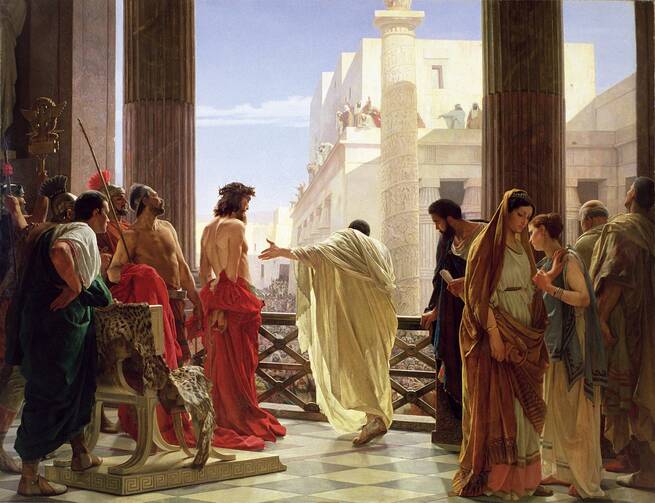A Reflection for Good Friday of the Lord’s Passion
Find today’s readings here.
And the soldiers wove a crown out of thorns and placed it on his head,
and clothed him in a purple cloak,
and they came to him and said,
“Hail, King of the Jews!”
And they struck him repeatedly.
Before returning home from a summer immersion in Guatemala, one of my Jesuit brothers showed me around the capital. After seeing the local Jesuit university and chatting over some pepián, we visited Nuestra Señora de la Merced, a parish in the city under the care of the Jesuit community.
Like many Jesuit parishes around the world, the church was built in the baroque style. This style of architecture is known for its extravagant, even theatrical quality, intended to astonish those who enter and look upon it. These churches are typically lined with stunning paintings and ornate side altars.
After Mass, as I walked through the church, I spent time at the different side altars. At one, pilgrims had laid a mountain of flowers at the foot of a shrine to St. Jude, along with prayers for intercession and healing. Another featured St. Ignatius of Loyola, Francis Xavier and some of the Jesuit martyrs. But one side altar was particularly striking.
This altar was dedicated to Christ’s Passion and the Sorrowful Mysteries. In the center of the altar was a large statue of Christ carrying his cross, surrounded by other, smaller statues depicting other moments: the agony in the garden, the scourging at the pillar and the crowning of thorns. I was struck by the contrast of Christ’s beaten and bruised body among all the gold and silver etchings.
But as I turned to view the portion of the side altar to my left, what I saw was truly arresting. Amidst more ornate, gold architecture was a statue of a scourged Jesus, crawling on the ground and naked. I know that even reading those words may be disturbing for many. Imagining such a statue may seem irreverent or scandalous. How could we depict Christ in such a way?
There is a reason we refer to it as the “scandal” of the cross. Christ is indeed King of Kings and the Universe, but today we’re called to recognize that before Christ was enthroned in heaven, he was beaten on earth. Neither the crown nor the cloak given to him by the Roman soldiers was a symbol of reverence, but a tool of mockery. Before we witness our resurrected savior in all his glory, today the Church asks us to see our brother Jesus wounded and humiliated.
If the incarnation is the greatest manifestation of God’s humility, Christ’s passion reveals its deepest demonstration. The one who was sent to proclaim liberty to the captives enters captivity himself. The one who used his spit to restore sight to the blind allows himself to be spat upon in scorn.
In the face of this scandal, this central mystery of our faith, we may feel overwhelmed and prone to distraction. Sadness and confusion may tempt us to look away. Scrupulosity may turn us inward and lead to sorrow, quickly co-opted by a self-loathing that is equally unfocused and unhelpful.
There are many great mystics and theologians who can help us navigate this mystery, but I want to suggest that we simply rest in these feelings for a moment and truly live in the spirit of Good Friday. Most of us will be participating in the liturgy from the pews, so I’d like to invite us to contemplate the simple yet profound instructions found in the lectionary before the proclamation of the Gospel:
“The passion narratives are proclaimed in full so that all see vividly the love of Christ for each person.”
Be sad. Be angry. Be moved to tears. These natural responses come from a real love and care for Jesus. Allowing ourselves to feel these emotions in their fullness offers us the opportunity to be close to Christ and share in his vulnerability as we enter this time of anticipation.








